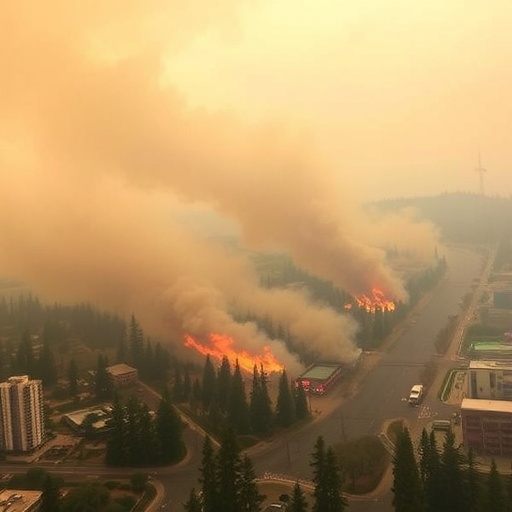A groundbreaking study published in Science has unveiled a critical oversight in how climate models evaluate wildfires’ impacts on air quality across the United States. For decades, prevailing scientific paradigms have focused predominantly on the role of wildfire smoke emissions, particularly fine particulate matter (PM2.5), as the primary driver of degraded air quality both near and far from wildfire events. However, this new research reveals that the intense heat generated by wildfires—often overlooked in modeling efforts—significantly alters atmospheric dynamics, with profound and unexpected consequences for regional air pollution, especially in areas far removed from the fire itself.
Wildfires in the western United States have surged in frequency and intensity over recent decades, exacerbated by climate change, drought, and increasing vegetation growth. These fires release enormous quantities of smoke laden with PM2.5 particles, recognized as a severe health hazard due to their ability to penetrate deep into the lungs and bloodstream, contributing to respiratory and cardiovascular diseases. Conventional wisdom has long held that smoke transported from the West to the East would inevitably worsen air quality in eastern states, leading to heightened morbidity and mortality, and influencing nationwide health policies accordingly.
Yet, the study led by Qihan Ma and colleagues challenges this deeply ingrained assumption by integrating daily measurements of wildfire heat flux into climate simulations. Previous models have largely neglected this crucial variable, focusing almost exclusively on the emission and transport of particulate matter. The research demonstrates that wildfire-generated heat is not merely a passive byproduct but an active force in modulating atmospheric circulation patterns, convection strength, and ultimately, the dispersal and deposition of pollutants.
Specifically, the authors find that during periods of extreme wildfires in the West, the intense thermal energy released induces robust convective activity. This process destabilizes the local atmosphere, altering large-scale weather patterns by effectively suppressing the eastward transport of smoke plumes. This suppression means that PM2.5 concentrations in the Eastern United States actually decline during these major fire events and throughout the wildfire season, contrary to long-held beliefs.
Moreover, the convective mechanisms triggered by fire heat promote increased precipitation downwind, further cleansing the air through the wet deposition of pollutants. This dual effect—restricted smoke movement and enhanced rain scavenging—creates a paradoxical situation where wildfires worsen air quality in the immediate western vicinity but simultaneously improve conditions in regions far to the east. Such a dynamic has profound implications for regional environmental equity, as air quality benefits in one region come at a significant local cost to others.
Importantly, the failure of most current climate models to incorporate fire heat dynamics results in substantial overestimations of both health and economic consequences attributed to wildfire smoke across the nation. The study quantifies this inflation, suggesting that ignoring fire heat leads to an overestimate of approximately 1,200 premature deaths and $3.3 billion in economic damages annually. This finding signals an urgent need to recalibrate environmental policies and resource allocation strategies based on a more nuanced understanding of wildfire impacts.
The research underscores a critical gap in Earth system models, which traditionally emphasize smoke emissions without sufficiently capturing the thermodynamic feedbacks induced by fire heat. As global warming accelerates vegetation regrowth, fuel loads are expected to increase, which will amplify the thermal energy released during wildfires. Therefore, excluding fire heat from comprehensive climate simulations risks underestimating future wildfire risks and their atmospheric and public health consequences.
Qihan Ma and the team’s integrative approach, combining high-resolution observational data with enhanced climate modeling, marks a significant advancement in wildfire science. It calls into question decades of assumptions underpinning regulatory frameworks for air quality management and wildfire preparedness. By highlighting the complex interplay between fire heat and atmospheric behavior, this study paves the way for more accurate predictions and holistic strategies to mitigate wildfire-associated risks.
The differential geographic impacts of wildfire heat elucidated by this research also raise important questions about environmental justice. Regions directly affected by poor air quality due to fire emissions—primarily in the West—are burdened with health hazards and economic costs, while areas in the East may enjoy incidental air quality benefits. Such disparities necessitate refined policy responses that consider spatial trade-offs and equitable resource distribution for fire management and pollution control.
Furthermore, this study aligns with emerging evidence that Earth’s climate system responds to localized forcings in complex, non-linear ways. The convective and circulatory changes induced by wildfire heat exemplify feedback loops that can either mitigate or exacerbate environmental challenges depending on context. Such insights have broader implications beyond wildfire science and air quality, potentially informing our understanding of extreme weather events and climate variability.
Given the dramatic shifts in wildfire regimes expected under ongoing climate change, incorporating fire heat into Earth system models should become a research priority. This inclusion will improve the reliability of wildfire risk assessments and forecast models, supporting better preparedness and adaptive management strategies. It will also enhance the accuracy of public health impact estimates critical for policymakers and health agencies.
In conclusion, the study by Ma et al. reveals an overlooked but vital dimension of wildfire dynamics: fire heat’s ability to reshape atmospheric circulation and thereby redefine the spatial distribution of air pollution. Recognizing and incorporating this factor challenges existing paradigms and has practical consequences for climate science, policy, and public health. Its findings call for a paradigm shift in how meteorological and environmental models conceptualize wildfire impacts and highlight the necessity of interdisciplinary approaches to tackle the complexities of a warming planet.
Subject of Research: Wildfire heat influence on atmospheric circulation and regional air quality in the United States.
Article Title: Fire heat affects the impacts of wildfires on air pollution in the United States
News Publication Date: 11-Sep-2025
Web References:
10.1126/science.ads1957
Keywords: wildfire heat, air quality, PM2.5, atmospheric convection, climate modeling, wildfire smoke transport, western United States wildfires, regional air pollution, atmospheric circulation, environmental equity, wildfire risk assessment, climate change.




